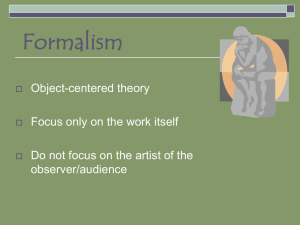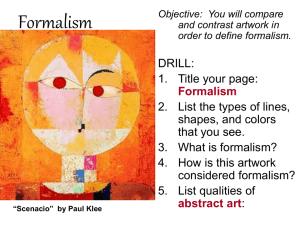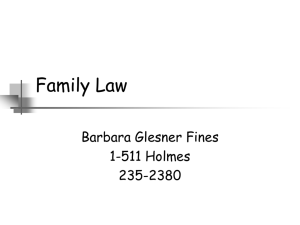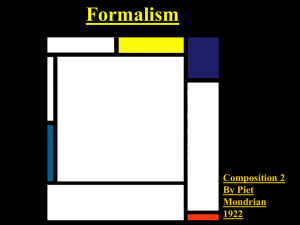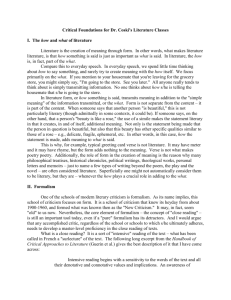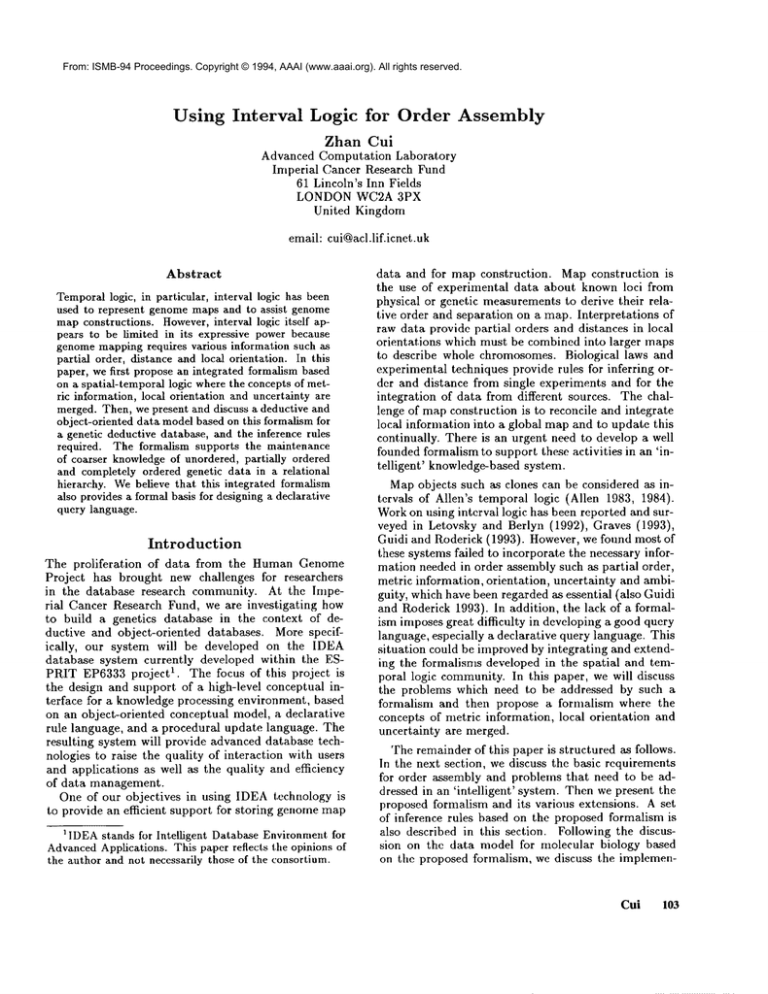
From: ISMB-94 Proceedings. Copyright © 1994, AAAI (www.aaai.org). All rights reserved.
Using
Interval
Logic
for
Order Assembly
Zhan Cui
Advanced Computation Laboratory
Imperial Cancer Research Fund
61 Lincoln’s Inn Fields
LONDON WC2A 3PX
United Kingdom
emaih cui@acl.lif.icnet.uk
Abstract
Temporallogic, in particular, interval logic has been
used to represent genomemaps and to assist genome
mapconstructions. However,interval logic itself appears to be bruited in its expressive powerbecause
genomemappingrequires various information such as
partial order, distance and local orientation. In this
paper, we first propose an integrated formalismbased
on a spatial-temporal logic wherethe concepts of metric information, local orientation and uncertainty are
merged. Then, we present and discuss a deductive and
object-oriented data modelbased on this formalismfor
a genetic deductive database, and the inference rules
required. The formalism supports the maintenance
of coarser knowledgeof unordered, partially ordered
and completely ordered genetic data in a relational
hierarchy. Webelieve that this integrated formalism
also providesa formal basis for designinga declarative
query language.
Introduction
The proliferation
of data from the Human Genome
Project has brought new challenges for researchers
in the database research community. At the Imperial Cancer Research Fund, we are investigating how
to build a genetics database in the context of deductive and object-oriented databases. More specifically, our system will be developed on the IDEA
database system currently developed within the ESPRIT EP6333 project 1. The focus of this project is
the design and sut)port of a high-level conceptual interface for a knowledgeprocessing environment, based
on an object-oriented conceptual model, a declarative
rule language, and a procedural update language. The
resulting system will provide advanced database technologies to raise the quality of interaction with users
and applications as well as the quality and efficiency
of data management.
One of our objectives in using IDEAtechnology is
to provide an efficient support for storing genomemap
a IDEAstands for Intelligent Database Environmentfor
AdvancedApplications. This paper reflects the opinions of
the author and not necessarily those of the consortium.
data and for map construction. Map construction is
the use of experimental data about known loci from
physical or genetic measurementsto derive their relative order and separation on a map. Interpretations of
raw data provide partial orders and distances in local
orientations which must be combined into larger maps
to describe whole chromosomes. Biological laws and
experimental techniques provide rules for inferring order and distance from single experiments and for the
integration of data from different sources. The challenge of mapconstruction is to reconcile and integrate
local information into a global mapand to update this
continually. There is an urgent need to develop a well
founded formalism to support these activities in an ’intelligent’ knowledge-basedsystem.
Mapobjects such a.s clones can be considered as intervals of Allen’s temporal logic (Allen 1983, 1984).
Workon using interval logic has been reported and surveyed in Letovsky and Berlyn (1992), Graves (1993),
Guidi and Roderick (1993). However, we found most
these systems failed to incorporate the necessary information needed in order assembly such as partial order,
metric information, orientation, uncertainty and ambiguity, which have been regarded as essential (also Guidi
and Roderick 1993). In addition, the lack of a formalism imposes great difficulty in developing a good query
language, especially a declarative query language. This
situation could be improved by integrating and extending the formalisms developed in the spatial and temporal logic community.In this paper, we will discuss
the problems which need to be addressed by such a
formalism and then propose a formalism where the
concepts of metric information, local orientation and
uncertainty are merged.
The remainder of this paper is structured as follows.
In the next section, we discuss the basic requirements
for order assembly and problems that need to be addressed in an ’intelligent’ system. Then we present the
proposed formalisna and its various extensions. A set
of inference rules based on the proposed formalism is
also described in this section. Following the discussion on the data model for molecular biology based
on the proposed formalism, wc discuss t.he implemen-
Cui
103
tation and its related issues, l,’inally, we conclude tile
paper with the main features of this formalism and the
further work.
Problems
Genomemapsfall into several basic categories: genetic
linkage maps, cytogenetic maps and molecular-ba.sed
physical maps. Figure 1 from Ilonda, I)arrot, Smith
and Lawrence (199:1) illustrates
seine typical genome
nlaps at ditferent resolutions of details from the lowest. level of chromosomehands to the highest level of
nueleotide sequences.
P, reakp~int
Genetic
MI
I
A
M2
II
B
M3
I
A
I
("
B
"~
---o--@
AG(X?CGA’ITAA(;
M4
....
Physical
I I
C
C
"0--""--0-
GCCAATG’VI’ACGGA
(’untig
s’rs
Figure 1: C, enome related maps
As can be seen fronl the tigure, these maps are basically 1-dimensional and are akin to problems dealt
with by temporal logic. Indeed, several systems based
on temporal logics have been built. Letovsky arid
Berlyn (’1992) described a point set ontology for their
constraint-based system. In their system, only one relation before is used, and local ordering windowsare
introduced to handle the orientation uncertainty. An
interesting set of inference rules are presented to derive the global ordering. Gnidi and Roderick (1993)
planned to use Allen’s interval-like logic to repre.sent
partial ordering to cope with uncertainty in the fragments of DNAsequences, but front their short surw,y
paper it is not clear how they propose to use them.
Honda et al. 11993) proposes an object-oriented data
model which is also based on the general idea of linear
ordering. One slightly different approach is reported
in Graves (1993), who developed a general knowledgebased system based on connection graph and a single
order relation.
There are, howe.ver, sotne significant differences bet.ween temporal logic and genomics. Wecan view both
104
ISMB-94
I)NAfragments and probes as int, ervals, but their orders are usually only true in somelocal frame of reference. Second/y, experiments are designed to produce
ow’.rlapping fragments and we normally do not know
the precise beginnings and endings of intervals. The
partial orders from experiments are often uncertain due
to exi~erimental errors. Thirdly, conflicting orders may
be reporl.ed by different experiments, which must. be
represented and stored in the database because those
conflicting results might haw: some biological explanations yet to be discovered, l"urthermore, the algorit.hnls for constructing orders of genetic markers use
various sources of information such as partial ordering,
distance and orientation. All this demandsa formalism
n,ore expressive than Allen’s interval logic: it. nmst be
flexible enough to support the diversity of raw data required by different map construction algorithms. Some
of the key re(luireme.nts are:
Imprecise data: hnprecise information abounds in
genetics. Allen’s interval logic imposes precise information between intervals. Although uncertainty relations can be represented by disjunctions, the computational cost is high. In recent papers, Freksa (1992)
has propose.d "conceptual neighbourhood" to encode
imprecise irfformation. It would be very appealing to
develop a formalism along this line where imprecise information can be represented in a retinelnent hierarchy.
Metric data: Metric information must be represented. (leneticists often use it. to derive new order
information. Several successful mapping syst.ems require distances between genetic markers.
Local orientation: This is missing from most of the
spatial and temporal logics, but must be supported.
Due to the nature of the experiment, the marker ordering information obtained is usually local to a particular
reference frame.
Relations between DNAfraglnents:
Most of the
systems we are aware of support only a very limited
number of relations when in fact there are many possibilities,
q’he relations between two DNAfragments
reported from experiments can be described a.s separated, adjacent, overlapping, contained, etc. A set of
binary relations is needed to represent the coarseness of
our knowledge about two fragments or intervals. Furthermore, we also need to represent data which may
be unordered, partially ordered or completely ordered.
Uncertainty: Uncertainty can come from different
sources in this context. Experimental data are usually
associated with experimental errors and ambiguousresults may bc reported by different experiments. Even
if we have certain data, uncertainty maybe present after one cycle of inferences (Freksa 1992). Uncertainty
management can keep a database consistent and report inconsistency, h, addition, it may provide a way
to manageinconsistency in the database.
haferenee rules:
A set of new inference rules is
needed to reason with the partial order, local orientation and ambiguity, etc ira this domain. Letovsky and
C(x,y) DC(x,y) P(x,y) PP(x,y) O(x,y) DR(x,y)
TPP(x,y) NTPP(x,y)PO(x,y)
I I I I I I I
o@@
@
©
O
o
I
o0@
°oo ©
O
O
Figure 2: A set of sample configurations (in 2D) modelling the defined relations.
Berlyn (1992) have shownthe usefulness of these rules
in their CPROPprogram.
Declarative
query language: The importance of
declarative query language for a genetic database has
been evidenced by tile use of Prolog in several genetic
databases (Kazic et al. 1990, Yoshida et al. 1992).
A good query language for a genome map database
will give the user great flexibility to construct complex
queries including recursive queries.
A Proposed
Formalism
In a genomcdatabase, especially a database for genome
mappinginformation, there is a need to represent different levels of information from cytogenetic through
linkage map to physical and sequence data. Although
Allen’s interval logic provides a set of base relations,
no higher level relations are defined. Recent work of
Freksa (1992) has shown how weaker spatial/temporal
relations can be defined using semi-intervals, but it is
not clear howto arrange them in a relational hierarchy.
The work of Randell et al. (1992), Cui et al. (1993)
spatial logic has presented their binary relations in a
relational hierarchy which can be exploited in several
ways. This logic can also bc extended to define all of
the 13 nmtually exclusive interval relations of Allen’s
logic. In this section, we will start from this formalism, and then move onto the extensions to handle the
problems mentioned above.
The Formalism
The basic ontological entity in this formalism is a region; note that boundaries, lines and points are not
regions. Regions are non empty. Regions in the theory support either a spatial or temporal interpretation.
Informally, these regions may be thought to be potentially infinite in number, and any degree of connection between them is allowed in the intended model,
from cxternM contact to identity in terms of mutually
shared parts. The formalism supports two or three dimensional interpretations (or higher dimensions!).
is based upon Clarke’s (1981, 1985) calculus of individuals based on "connection" and is expres~d in the
many sorted logic LLAMA
(Cohn 1987).
Wehave used the standard convcrltions of first order
logic. These are summarised in Table 1. Note that
the axioms in the following would be more complex
without using many sorted logic. For example, the
first axiom: VxC(x,x) would beconmVx[R.egion(x)
The ba.~ic part of the formalism assumes one primitive dyadic relation: C(x, y) read as ’x connects with
y’. The relation C(x, y) is reflexive and symmetric, ic,
x connects with x and if x connects with y, then y
connects with x. Wecan give a topological model to
interpret the theory, namely that C(x, y) holds when
the topological closures of regions x and y share a commonpoint. Twoaxioms are thus introduced.
(1) VxC(x,x)
(2) y) --+ c(:j,
Using C(x, y), a basic set of dyadic relations are defined: ’DC(x, y)’ (’x is disconnected from y’), ’P(x, y)’
(’x is a part of y’), ’PP(x,y) (’x is a proper part
y’), ’x = y’ (’x is identical with y’), ’O(x, y)’ (’x overlaps y’), ’DR(x, y)’ (’x is discrete from y’) TO(x,
(’x partially overlaps y’), ’EC(x, y)’ (’x is externally
connected with y)’, ’TPP(x,y)’ (’x is a tangential
Cui
1o5
PO(a,b)TPP(a,b)NTPP(a,b)
"l(a,bEC(a,b)DC(a,b)
Figure 3: A lattice defining tile subsumptionhierarchy of the dyadic relations defined solely in terms of the primitive
relation C(x, y).
pairwise disjoint.
negation:
-~
not
conjunction:
A
and
disjunction:
V
or
implication:
---+
if then
bi-implication:
~
if aud only if
existential quantifier:
3
there exists
(9) DR(x,y) =--de!
~O(x, y)
(10) EC(x, =~e
j’ C(x, y) A -~O(x, y)
(11) TPP(x,y) =--d~f PP(x,y)A
V
for all
(12) NTPP(x,y)
-dcy
equivalent
(13)
(14)
(15)
(16)
universal quantifier:
definition:
’Fable 1: Symbolsused in the a~xiomatization
proper part of y’) and ’NTPP(x,y)’ (’x is a nontangential proper part of y’). The relations: P, PP,TPP
and NTPP being non-symmetrical support inverses:
p-l, pp-t ,i, pp-1 and NTPP-1. Of the defined relations, DC,EC,PO,=,TPP, NTPPand the inverses for
TPP and NTPParc provably mutually exhaustive and
106
ISMB-94
(3) DC(x, y) -dry ~C(x,
(4)P(z, y) :d~IVz[C(z, x)-~C(z, y)]
(5) PP(x, y) ~dCf P(x, y) A -,P(y,
(6) x = y -~d~] P(x, y) A P(y,
(7) O(x, y) --drI 3z[P(z, x) A P(z,
(8) eo(x,y) --d~fO(x,y) A-,e(z, y) A-,P(y,
3:[EC(:,x) AEC(:,
-~def
PP(x,y)A
-~3z[EC(:,
~) ABe(:,
P-l(x,y) =--d~,!
P(y,x)
PP-l(x,y) --d~:PP(y,x)
TPP-t(x, y) ~d~f’rVP(y, z)
NTPP-~(x, y) ---at] NTPP(y,
A pictorial representation of the relations defined
above is given in I,’igure 2 and their relational hierarchy in Figure 3.
The formalism has a temporal interpretation by introducing another primitive relation B(x, y) .- of x being before y. The formal definitions for Allen’s interval relation before (<), meets (m), overlaps (o),
(d), starts (s), finishes (f) and their inverses (>,
di, si and fi) are given below
< (z, y) -----d,I DC(x,y) A B(z,
> (z, y) =&! De(x, y) A B(y,
m(x, y) ----de/’ EC(x,y) A B(x,
mi(z, y) =dey EO(x, y) A B(y,
o(x, y) --de! PO(z, y) 3z[m(z, z) A -~m
(z, y)]
oi(x, y) =--clef PO(x,y) A 3z[mi(z, z) A -~mi(z,
d(z, y) _=&! NTPP(z,
di(x, y) =de! NTPP(y,
s(z, y) --de! TPP(x, y) A qz[m(z, z) A re(z,
si(z, y) =d~YTPP(x, y) A qz[mi(z, x) A mi(z,
f(x, y) ~d,.f DC(x,y) A 3z[mi(z, x) A mi(z,
fi(z, y) =del DC(x, y) A 3z[m(z, z) A m(z,
Nowthe leaf nodes in Figure 3 can be further refined
to include all of the Allen’s 13 interval relations just
defined when used to represent one dimensional space.
Metric extension
So far we have principally concentrated on developing
a purely qualitative calculus. However,this can never
be a replacement for metric information, but rather
should complement a metric representation.
Indeed,
distance is considered to be an important source of
information in genome mapping algorithms (Letovsky
and Berlyn 1992). In CPROP,distance is used to form
several inference rules and Guidi and Roderick (1993)
show how distances alone can sometimes give precise
orders.
There is a close relationship between the metric information and the binary relations described in section
3.1 and distances when only one dimensional space is
considered. All of the 13 base relations can be defined
by using the relations between the endpoints of intervals (Allen 1983, Kauts and Ladkin 1991, Freksa 1992).
The correspondence between them has been shown in
Table 2. However, we should note that endpoints are
qualitative in nature because the precise measure of
endpoints, particularly of clones, maynot be available.
Weshould also note that the distance between intervals can be used as a measure of their endpoints.
Hence, all the techniques in dealing with numbers can
be readily used together with the techniques for interval reasoning. This provides a natural link between
topological relations and distances. Wecan use them
to develop a fast inference rule for the derivation of
new order relations. The techniques presentcd in qualitative simulation and spatial reasoning in databases
(Cui et al. 1992, 1993) should also be useful here.
Orientation
Due to the nature of experiments,
ally only reported with reference
tion and thus with an uncertainty
der. Letovsky and Berlyn (1992)
locus order is usuto a local orientaover the global orhave presented
a before b
e(a) < s(b)
a = b
s(a) = s(b)
e(a) = e(b)
a meets b
e(a) = s(b)
a overlaps b
s(a) > s(b)
e(a) < e(b)
e(a) > s(b)
a during b
s(a) > s(b)
e(a) < e(b)
a starts b
s(a) = s(b)
e(a) < e(b)
a finishes b
e(a) = e(b)
s(a) > s(b)
Table 2: Correspondence between interval relations
and their endpoints, s(x) denotes the beginning of interval z and e(x) the ending.
excellent treatment of orientation uncertainty by introducing local orientation windows. This idea of local
orientation can be easily incorporated into the formalism just presented since the basic formalism does not
require orientation to be specified. Hence, a special
inference layer can be introduced to handle local orientation. As we associate a set of genetic markers with
a particular orientation without refcrence to the global
orientation, the derived facts within that particular set
of markers will still hold even if we movethem around.
This is particularly useful in the genetic domainsince
the exact position of a locus may not be fixed due to
incomplete knowledge.
The techniques for merging two local orientations
(LO) use the facts that only one base relation can hold
for a pair of markers. We can emphasise that markers occupy space by cMling them intervals. The base
relation (order relationship) between two intervals
two separate local orientations can not be inconsistent.
Thus we can deduce the relative order of two local orientations and merge their data. For example, we can
conclude that LOj is the inverse of LOi from
A before B before C, in LOi
D before C before B, in LOj
Therefore,
A before B before C before D, in LOi
Wehave constructed a complete composition table
for combiningtwo local orientations for all the combinations of the base relations. Not all the base relations
Cui
107
give orientation information. For example, TPP and
NTPPcan be true in any orientation frame. The base
relations that do fix orientation information are before,
after, meet and its inverse, overlap and its inverse. The
composition table not only provide an efficient way to
merge two local orientatious, but also can be used to
detect inconsistencies in the raw data. For example,
unlike the merging of local orientations above, information given in two local orientations can lead to contradiction no matter how we interpret the two local
orientations and further experimentation may be required.
Inference
Rules
The formalism supports a new set of inference rules.
By exploiting the lattice structures presented in the
fornialism, we may be able to implelnent these inference rules effectively. For exanlple, given two relations:
RI(A, B) and R2(B, C’), the relation between A and
can be derived. This allows us to calculate a composition table (or transitivity table) for all combinations
the base relations. There are two composition tables in
our formalism: one for the 13 Allen’s interval relations
and one for the base relations (before the temporal extension) presented in Figure 3. Due to the space limitation, we could not present the two tables here. tIowever, they can be found in Allen (1984) and Randell
et al. (1992). Wehave also developed other inference
rules similar to CPROP’s(Letovsky and Berlyn 1992).
In CPROP,the merging of local orientation windows
was considered as an application of inference rules. In
our case, we regard this as preprocessing because we
found that to do otherwise would unnecessarily coinplicate our inference engine.
By expressing all the possible relations between intervals, our formalism allows maximaluse of available
informatiou in map asselnbly. For example, the relation ’contains’ is usually considered to be no use in the
genome mapping processing, ttowever, this information can be used to derive orders in our representation. Figure 4 shows an example of the use of interval
logic ill automated reasoning. Suppose we have data
from three separate experiments (1, 2 and 3) concerning three loci: A, B and C. Experiment 1 reveals a
partial overlap between A and C: PO(A, C), which
mayhave the two local orientations as shown. Experiment 2 shows that locus C lies before B: B(C:, B), and
Experiment 3 detects that locus A contains locus B,
expressed as B is a proper part of A: PP(B, A). Without using PP(B, A), there are two possible cases shown
in Figure 4. IIowever, this alnbiguity can be resolved
by PP(B, A) because case b then becomes inconsistent
with the data.
Data Model
The integrated formalism has many properties which
could not be readily and efficiently represented and exploited by conventional databases. For exanlple, Fig108
ISMB-94
AI
I
b~,,,~,t
Figure 4: An exalnple of containmentrelations usedin
order reasoning
]are 3 suggests that the binary relations of I)NA fragments can be represented in an inheritance hierarchy,
which could not be efficiently supported in a relational
data model. In the following, our discussion is based
on a deductive and object-oriented representation.
Object-oriented modelling provides a natural means
of representing the complex, often composite structures in molecular biology by the inheritance of attributes and behaviours. The deductiw, capabilities
enable us to store biological rules in the database in the
form of Prolog (Kazic et al. 1990). Although databases
based on object-oriented models have been successfully
used in several humangenomeprojects (Yoshida et al.
1992, Honda et al. 1993), the work on deductive and
object-oriented data models (DOOD)is less advanced.
Oneof the difficulties is due to the lack of a suitable formalism to encode the biological knowledge in DOOD.
Webelieve that the proposed formalism may provide
a basis for representing this body of knowledge.
In our data model, we have identified the following
classes, each of which corresponds to independent entities ill the domain:chronlosonle, probe, clone, gene,
YAC,cosmid, STS fragments, protein, enzyme, restriction sites, etc.; someother entities are related to experiments: agents, protocols, etc, and still other entities
correspond to binary relations such as orders. Most
of these entities can be straightforwardly defined as
classes with simple attributes and simple passive rules
(Ceri and Manthey 1993). For example,
class chromosome_band
=
attributes
name: string,
chromosome:int,
arm: string,
length:real,
first_locus:locus,
last_locus:locus
end
i
p23
p22
~ p21
.:.:," plg
"" p
¯ prdDQ(S)
lCCUS:
cdS~
probeCs)
hue: cd~J<r1_t~cdBa_~rl_2
podia2_14
....,,:’:’:"
pl 1_2
".," p11_1
~"" .:an
q11_1
qll 2
:;:.:~q?2
~
(~
InSl~nc~s0 0=
,as=o
-
:.:,:..q14_t
q14_2
~
q~4_3
.]:~:]q2z
q23
InpUtp
d 3
name
I~n9name
c~oscrno
a~m
upper
band
lowerband
bpten<jth
q .2
Implt
0
OUtpltI~1 deP~ult
imp~2
~"~-"~ Olitput
/ep~(~
~ default
,,,,t 0
m q~l
~ q32.2
q32_3
q33
.:::::.q_’34
~ .7.,
qter
Imp=I
Figure 5: A screendumpof our graphical interface for our prototype implementation
The binary relationships between two DNAfragments are also defined as objects. However,these objects are classified accordingto the hierarchy in Figure
3 with the leaf nodes further split to include all 13 of
Allen’s interval relations. Morespecifically, we define
one class for each node in Figure 3. Thetop level class
(or node) includes the generic attributes such as mapobjects ~, distances and local orientations. The rules
for translating metric information to topological one
are defined as passive rules (also see Ceri and Manthey 1993, Jonker et al. 1994). The leaf classes rep¯ resent the precise relations betweentwo genetic fragments we knowabout in the database. Imprecise informationis capturedby the higher level classes with the
highest level class representing completely unordered
fragments. The ambiguous orders are represented by
multiple instances in our database.
Implementation
The data model described in the previous section can
be implemented on a deductive and object-oriented
database. As we are participating the IDEAproject,
we have implemented our system on the IDEAprototype deductive and object-oriented database. How~Mapobjects (equivalent in function to intervals in
Allen’s logic) are object identifiers for DNA
fragments,ordered maps,etc.
ever, the prototype has not yet provided all the functionality requiredat this stage. Instead, we have implemented our static data model and some passive rules
in the IDEAprototype database, and implemented the
inference mechanismand active behaviours in SLOT
(Cui, Fox and Hearne 1993, FIearne et al. 1994, Cui
and Fox 1994) - a specification language for building deductive and object-oriented theories, which combines the advantages of both logic programmingand
object-oriented
programming paradigms. SLOTdivides an ~pplication into manysubtheories. Each theory has its ownlocal database, and ways to interact
with other theories. A local database is designed in
such a way that it is described in Prolog and can
be automatically translated into deductive and objectoriented databases. In our case, the target language
is Chimera (Ceri and Manthey 1993) - a conceptual
modeling language for the IDEAproject.
Wehave used special SLOTtheories for handling
uncertainty and ambiguity data and theories for using
inference rules. Users can interact with the system
through a graphical use interface or by issuing Prolog
form queries. Figure 5 provides a screen dumpfor a
particular session. Moredetails can be found in Jonker
et al. (1994).
So far the proposedformalismhas not yet been fully
implemented in our database system. Wehave begun
to investigate the implementation along two possible
Cui
109
lines. One involves using theorem proving techniques
in which the reasoning process will take several steps.
First, metric information is translated into topological
relations. Then a special spatial logic theoremprover is
employed to derive as muchas possible new topological
information in each local orientation frame. Since there
are usuMly a few intervals (DNAfragments) in each
local orientation frame, this process will be reasonably
fast. After that, we merge local orientations, and then
construct the global ordering.
~¥e can also implement the proposed formalism
along the line of qualitative simulation developed in
Cui et al. (1992). One advantage of this approach
that distances can be directly used with the topological relations and no translation is required. The final
results are usually a set of possible orders for the given
intervals (DNAfragments in our case).
Conclusion
In this paper, we have discussed the problems in building a large deductive and object-oriented database to
support molecular biology, especially problems related
to represent and construct genome maps. We have
described an integrated formalism based on a spatial
and temporal logic, which extends Allen’s interval logic
to include metric information and local orientation.
The binary relations form a relational hierarchy corresponding to the coarseness of our knowledgeabout tile
relationship
between two DNAfragments. For example, unordered fragments are represented by the highest level relation; imprecisely ordered fragments by the
middle relations and precisely ordered fragments by the
leaf relations in the relational hierarchy.
Based on this integrated formalism, we have designed a deductive and object-oriented data model for
molecular biology. Wehave partially implemented this
in a prototype database system offered by the IDEA
project, together with a formal object-oriented specification system SLOT(Jonker et at. 1994, Cui et
al. 1993, Cui and Fox 1994) because the prototype
database system does not yet support all the functionalities required. Our initial experience has shownthe
adequacy of our formalism for representing and reasoning with various source information in the context
of Human Genome project.
There are clearly several areas that need to be investigated further. Our initial database needs to be expanded to include more data and this will suggest how
we can improve our data model and inference mechanism. Wewill work on a composition table for combining local orientations in the same spirit as the transitivity tables in spatial and temporal logic (Allen 1983,
Randall et al. 1992, Goodayet at. 1994). In addition,
the spatial logic we are using also supports splitting
or gapped intervals. This could be used to describe
loci that involve alternative splicing (Borderaux et M.
1990) and protein coding messages produced by splicing. Wealso intend to extend the formalism to handle
110
ISMB-94
uncertainty and conflicting experiment data, possibly
along the line of argumentation by Fox et al. (1992).
Wewouldalso like to design a general declarative query
language for our genetic database.
Acknowledgements
The financial support from IDEAproject is gratefully
acknowledged. Wethank Drs. Catherine Hearne, Simon Parsons and John Fox for their comments, suggestions and inspirations.
References
Allen, J. F. 1983. Maintaining Knowledgeabout Temporal Intervals. A CMTransactions on Database Systems, 15(3).
Allen, J. F. 1984. Towardsa General Theory of Action
and Time. Artificial Intelligence 23(2).
Bordereaux, D.; Fichelson, S.; Tambourin, P.; and
Gisselbrecht, S. 1990. Alternative splicing of the Evil zinc finger gene generates mRNAswhich differ by
the number of zinc finger motifs. Oncogene, 5.
Ceri, S.; and Manthey,R. 1993. First Specification of
Chinmra. IDEA.DE.2P.004.02.
Clarke, B. L. 1981. A Calculus of Individuals Based on
Connection. Notre Dame Journal of Formal LOGIC,
Vol. 2, No. 3.
Clarke, B. L. 1985. Individuals and Points. Notre
DameJournal of Formal LOGIC, Vol. 26, No. l.
Cohn, A. G. 1987. A More Expressive Formulation of
ManySorted Logic. Journal of Automatic Reasoning,
Vol. 3 No. 2.
Cui, Z; Cohn, A. G.; and Randcll, D. A. 1992. Qualitative Simulation Based On A Logical Formalism of
Space and Time. In proceedings of AAAI92.
Cui, Z; Cohn, A. G.; and Randall, D. A. 1993.
Qualitative and Topological Relationships in Spatial
Databases. Advances in Spatial Databases, ads. D.
Abel and B. C. Ooi, Lecture Notes in Computer Science 692.
Cui , Z.; and Fox, J. 1994. A General Frameworkfor
Building Intelligent Database Applications. to appear
in the proceedings of the 3rd Golden West International Conference on Intelligent Systems, Las Vegas.
Cui, Z.; Fox, J.; and Hearne, C. 1993. Knowledge
based Systems for Molecular Biology: the Role of
Advanced Database Technology and Formal Specification. In Proceedings of IJCAI93 workshop on AI
and Genome, Chambery.
Fox, J.; Krause, P.; and Ambler, S. 1992. Arguments,
Contradictions and Practical Reasoning. in Proceedings of ECAI92,Vienna.
Freksa, C. 1992. Temporal Reasoning Based on SemiIntervals. Artificial Intelligence, 54, pp. 199 227.
Gooday, J. M.; Bennett, B.; and Cohn, A. G. 1994.
Efficient Generation of Composition Tables and Their
Compaction. Techniqal Report, School of Computer
Studies, Leeds University.
Graves, M. 1993. Integrating Order and Distance Relationships from Heterogeneous Maps. In Proceedings
of ISMB93.
Guidi, J. N.; and Roderick, T. H. 1993. Inference
of Order in Genetic Systems", In Proceedings of
ISMB93.
Han, K.; and Noordewier, M. 1992. An Efficient Algorithm for Ordering RandomGenomic Clones. Tech.
Report, Computer Science Department, Rutgers University.
Hearne, C; Cui, Z.; Parsons, S; and Hajnal. 1994.
Prototyping a Genetics Deductive Database", in Proceedings of ISMB94,this volume.
Honda, S.; Parrott, N. W.; Smith, R.I and Lwarence,
C. 1993. An Object Model for GenomeInformation at
All Levels of Resolution. In Proceedings of ISMB93.
Jonker, W.; Bressan, S.; Sikeler, A; Hearne, C; Parsons, S.; and Cui, Z. 1994. On the Use of IDEA
Database Technology in Molecular Biology. Technical Report, Imperial Cancer Research Fund, London.
Kautz, H. A.; and Ladkin, P. B. 1991. Integrating
Metric and Qualitative Temporal Reasoning. In proceedings of AAAI91, Anaheim, CA.
Kazic, T.; Lusk, E.; Olson, R.; Overbeek, R.; and
Thecke, S. 1990. Prototyping Databases in Prolog.
The Practice of Prolog, Leon Sterling, ed. MITPress.
Letovsky, S.; and Berlyn, M. B. 1992. CPROP: A
Rule-Based Program for Constructing Genetic Maps.
Genomics 12, pp435-446.
Mott, R.; Grigoriev, A.; Maier, E.; Hoheisel, J.; and
Lehrach, H. 1993. Algorithm and Software Tools for
Ordering Clone Libraries: application to the mapping
of the genome of Schizosaccharomyces pombe. Nuc.
Acids Res. 21, pp1965-1974.
Olsen, M.; Hood, L.; Ca~ltor, C.; and Botstein, D.
1989. A CommonLanguage for Physical Mapping of
the HumanGenome. Science 245, pp. 1434 - 1435.
Pecherer, R. M. 1993. Contig Graph Tool: A Graphical Interface for Contig Physical MapAssembly. In
proceedings of Hawaii conf. of system sciences.
Randell, D. A.; and Cohn, A. G. 1992. Exploiting
Lattice in a Theory of Space and Time. Computers
and Mathematics with Applications.
Randell, D. A.; Cui, Z.; and Cohn, A. G. 1992. A
Spatial Logic based on Regions and Connection. In
Proceedings of the 3rd Int Conf on the Principles
of Knowledge Representation and Reasoning, Morgan
Kaufmann.
Yoshida, K.; Smith, C.; Kazic, T.; Michaels, G.; Taylor, R.; Zawada, D.; Hagstrom, R.; and Overbeek, R.
1992. Toward a Human Genome Encyclopaedia.
In
Proceedings of Int. Conf. Fifth Gen. Comp. Systems,
307, ICOT.
Cui
111

